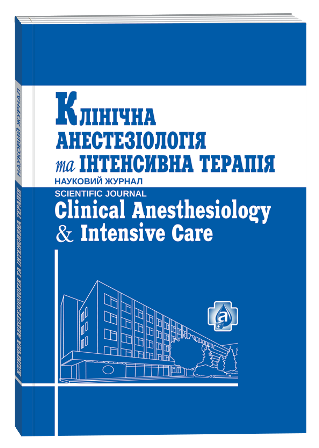THE NEW BIOMARKERS OF SEVERE SEPSIS AND SEPTIC SHOCK (an analytic review)
Keywords:
severe sepsis, septic shock, biomarkers of sepsisAbstract
Severe sepsis and septic shock are common and often fatal complications in patients who are in critical conditions. At the same time the profound search for adequate and specific biomarkers of sepsis is continuing. T. Lagu et al. (2012) identified a rapid and sustained increase in the incidence of severe sepsis in the United States from 415,280 in 2003 to 711,736 in 2007 (71%). The ratio of patients with severe sepsis and one organ dysfunction decreased from 51% in 2003 to 45% in 2007, where as the patients with 3–4 or more organ dysfunction increased 1.19 times and 1.51 times correspondently. At the same time, there was an annual decrease in hospital mortality by 2% (p<0.001). The authors associate this fact with the strict observance of the diagnostic algorithm and intensive therapy for severe sepsis and septic shock. It was established that markers of endothelial activation are associated with the severity of sepsis, organ dysfunction and mortality in sepsis. The article presents new biomarkers for the diagnostic of severe sepsis and septic shock, assess the severity of disease and the effectiveness of antimicrobial therapy, predicting morbidity and mortality of patients in intensive care units.
References
Вельков В. В. Пресептин — новый высокоэффективный биомаркер сепсиса / В. В. Вельков // Клинико-лабораторный консилиум. – 2012. – № 2 (42). – С. 56–62.
Биохимические маркеры системной воспалительной реакции: роль прокальцитонина в диагностике сепсиса / Б. Р. Гельфанд, С. З. Бурневич, Е. Б. Гельфанд [и др.] // Инфекции в хирургии. – 2007. – Т. 5, № 1. – С. 53–55.
Мониторинг-детерминированная стратегия антибактериальной терапии у больных с тяжелым сепсисом и септическим шоком / Л. А. Мальцева, Н. Ф. Мосенцев, Н. В. Федоренко, Л. В. Куник // Український журнал екстремальної медицини ім. Г. О. Можаєва. – 2013. – № 1. – С. 162–166.
Chist-Crain M. Procalcitonin in bacterial infetions — hype, hope, more or less / M. Chist-Crain, B. Muller // Swiss Med Wkly. – 2005. – N 135. – P. 451–460.
Chuang J. C. Using the rate of bacterial clearance determined by real-time polymerase chain reaction as a timely surrogate marker to evaluate the appropriateness of antibiotic usage in critical patients with Acinetobacter baumanii bacteremia / J. C. Chuang, S. C. Chang, W. K. Wang // Crit Care Med. – 2012. – Vol. 40, N 8. – P. 2213–2280.
Guan J. Dynamic change of procalcitonin, rather than concentration itself, is predictive of survival in septic shock patients when beyond 10 ng/ml / J. Guan, Z. Lin, H. Lue // Shock. – 2011. – N 36. – P. 570–574.
The value of serum procalcitonin level for differentiation of infectious from noninfectious causes of fever after orthopaedic surgery / S. Hunziker, T. Hugle, K. Schuchard [et al.] // J. Bone Joint Surg. Am. – 2010. – N 92. – P. 138–148.
Nationwide trends of severe sepsis in the 21s century (2000–2007) / Critical Care Outcomes Research (MICCOR) Group of Investigators / G. Kumar, N. Kumar, A. Taneja [et al.] // Chest. – 2011. – N 140. – P. 1223–1231.
Hospitalizations, costs and outcomes of severe sepsis in the United States 2003 to 2007 / T. Lagu, M. B. Rothberg, M. Shieh [et al.] // Critical Care Medcine. – 2012. – Vol. 40, N 3. – P. 754–761.
Ljungstrom L. R. Neutrophil-lymphocyte count ratio as a biomarker of severe sepsis in Escherichia Coli infections in adult / L. R. Ljungstrom, G. Jacobsson, R. Andersson // Crit Care. – 2003. – N 17. – P. 25.
Murray P. R. Current approaches to the diagnosis of bacterial and fungal bloodstream infections in the intensive care unit / P. R. Murray, H. Masur // Crit Care Med. – 2012. – N 40. – P. 3277–3282.
Okamura Y. Developmentof a point of care assay system for measurement of presepsin (sCD14-ST) / Y. Okamura, H. Yokoi // Clin. Chim. Acta. – 2011. – N 412. – P. 2157–2161.
Zongitudinal changes in procalcitonin in a heterogeneosus group of critically ill patients / S. C. Reynolds, A. F. Shorr, J. Muscedere [et al.] // Crit Care Med. – 2012. – N 40. – P. 2781–2787.
Bioenergetics, mitochondrial dysfunction and oxidative stress in the pathophysiology of sepsis encephalopathy / C. Ritter, R. Sonneville, F. A. Bozza [et al.] // Shock. – 2013. – N 39. – P. 10–16.
Serum levels of presepsin reflects the APACHE II and SOFA scores in patients with sepsis / R. Sato, J. Suzuki, M. Sato [et al.] // Critical Care. – 2013. – N 17. – P. 37.
The new sepsis marker, sCD14-ST, induction mechanism in te rabbit sepsis models / K. Shirakawa, K. Naitou, J. Hirose [et al.] // Critical Care. – 2010. – N 14. – P. 19.
Usefullness of presepsin (sCD14-ST) measurements as a marker for the diagnosis and severity of sepsis that satisfied diagnostic criteria of systemic inflammatory response syndrome / T. Shozushima, G. Tarahashi, N. Matsumoto [et al.] // J. Infect. Chemother. – 2011. – N 17. – P. 764–769.
Biomarkers of endotelial cell activation in early sepsis / S. Skibsted, A. E. Jones, M. A. Puskarich [et al.] // Shock. – 2013. – N 39. – P. 427–432.
Wilson J. X. Sepsis-associated encephalopathy: evolving concept / J. X. Wilson, G. B. Young // Can J Neurol Sci. – 2003. – N 30. – P. 98–105.
Wolff M. What procalcitonin brins to management of sepsis in the ICU / M. Wolff, L. Bonadma // Crit Care. – 2010. – Vol. 14, N 12. – P. 1007.
Yip B. Eosinopenia as a predictor of unexpected re-admission and mortality after intensive care unit dischange / B. Yip, K. M. Ho // Anaesth Intensive Care. – 2013. – N 41. – P. 231–241.







